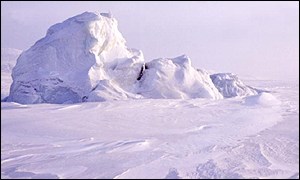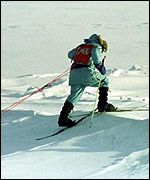
Dr James McCarthy, an oceanographer, says he found a mile-wide (1.6 km) stretch of open ocean on a recent trip to the region.
Some experts believe the ice cap could disappear altogether by the end of the 21st Century. They point to the rapid thinning of ice in the Arctic as further evidence of global warming.
But other scientists are less sure. They say movements in polar ice regularly create gaps in the ice cap - including at the North Pole itself.

Future explorers may need snorkels not skis
|
"It was totally unexpected," he said.
Another scientist on the cruise, palaeontologist Dr Malcolm C McKenna, said the ship was able to sail all the way to the North Pole through only a thin crust of ice, and arrived on the spot to discover no ice at all.
"I don't know if anybody in history ever got to 90 degrees north to be greeted by water, not ice," Dr McKenna was quoted as saying.
"Some folks who pooh-pooh global warming might wake up if shown that even the pole is beginning to melt at least sometimes."
Ivory gulls
The scientists say the ice cap in the whole area was so thin that the ship had to sail for another 10 kilometres (six miles) to find ice thick enough for the passengers to leave the boat and walk on the ice cap, as they had been promised.
The party also saw ivory gulls flying overhead, which ornithologists say is a first for the area.
Dr McCarthy, who is working on studies for the Intergovernmental Panel on Climate Change (IPCC), says he has previously found the North Pole covered in some 3 metres (9 feet) of ice during the summer.
Despite the lack of agreement over whether the North Pole stretch of water was as a result of melting or ice movement, scientists do agree that the ice cap in general is shrinking.
Analysis of data gathered by US Navy submarines have suggested that the ice draught in the Arctic (the difference between the surface of the ocean and the bottom of the ice pack) has thinned by more than 40% over the past 40 years.
Aug 19, 2000 - 02:12 PM
Warmer Weather Melts Ice at North Pole
The Associated Press
NEW YORK (AP) - For the first time in 50 million years, visitors to the
North Pole can see something extraordinary: water.
The thick ice that covers the Arctic Ocean at the North Pole has melted,
leaving a mile-wide stretch of water at the top of the world, The New York
Times reported Saturday.
Two recent visitors to the pole told the Times about the unexpected sight.
"I don't know if anybody in history ever got to 90 degrees north to be
greeted by water, not ice," said Malcolm C. McKenna, a paleontologist at the
American Museum of Natural History.
The water could be the result of global warming, although there is a debate
among experts about the cause. Some believe it could simply be a natural
occurrence rather than the result of a "greenhouse effect" caused by manmade
pollution and increased concentrations of carbon dioxide in the atmosphere.
Scientists have said that the last time the North Pole had this much water
was 50 million years ago.
For oceanographer James C. McCarthy, who visited the pole earlier this month
on a tourist cruise, the disappearing ice was a cause for concern.
Passengers aboard the cruise were shocked to find water when there has long
been only ice.
AP-ES-08-19-00 1414EDT